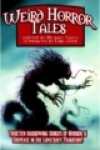Weird Horror Tales
Michael Vance
Cornerstone Book Publishers
Paperback, 208 pages, $24.95
Review by Frank Creed
After King and Poe, Lovecraft is widely acknowledged as one of the top three horror writers to impact American horror. Lovecraft’s horror world even has its own name: the Cthulhu (Kuh-Thoo-Loo) Mythos. Fans of Howard Phillip Lovecraft’s style, rejoice – there is an author you simply must meet. Algernon Blackwood and August Derleth have a stylistic contemporary in Michael Vance, a professional writer of non-fiction for over thirty years, who has mastered the short story form.
The award-winning Vance does not write in the Cthulhu Mythos itself, but his Lovecraftian style features patiently built suspense rich in setting and character, usually with short vivid climaxes and resolutions. Properly written, the effect puts a reader into the story, with page flipping curiosity.
Vance paints portraits of fated personalities in an eerie little town on Maine’s northern Atlantic coast. Light’s End can also be found on brink of madness. Deep spiritual influences and events, guilty evils, and ancient lore are scrimshawed into memorable tales centered on the moral implications and consequences of personal actions.
Vance’s voice is distinct from Lovecraft’s on several points. Horrors of the dark human heart, rather than horrific alien mysteries, are the center of each work. Readers are snatched from madness’ edge by an overall Christian worldview, which gives horror, and moral choices, context.
Weird Horror Tales’ thirteen short stories, and a few non-short story treats, showcase a Lovecraftian sins-of-the-fathers theme. The collection is what’s known as a braided novel. The tales, all in and around Light’s End, are set chronologically from the early twentieth century, to present day and near future. Common threads of symbol and prophecy progress through the stories. Any of the stories could be enjoyed individually, but read sequentially, there’s a bigger tale.
Vance’s fiction does not cower from language and subjects that most Christian publishers avoid. Vance uses dark imagery and language in a tasteful and literary sense. Pre-teens would see examples of good literature, but graphic content is appropriate for high school and older maturity levels
Sadly, Vance’s literary level may be too high. I fear readers won’t like “Random Pairings:” a literary dialog, boldly written without quotation marks, with one of the most dramatic endings in the braided novel.
Overall, Weird Horror Tales is a must-read for genre fans, especially those who of the Christian worldview. Note that one tale, “The Lighter Side,” should be saved for a reader’s zany reading mood. When you want something fun, the humor in this piece rivals Douglas Adams and Stephen Leon Rice.










This book looks awesome. I am a huge Lovecraft and Poe fan. Dreams of Terror and Death come to mind. I actually hope to collect stories like this for myself and create a compilation of them to further delve into the human experience.